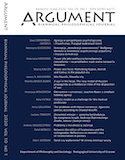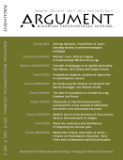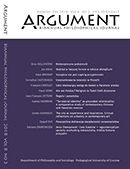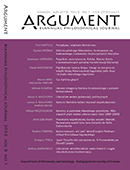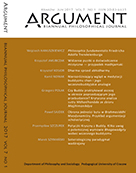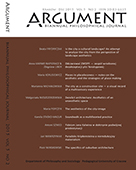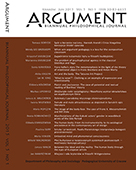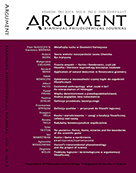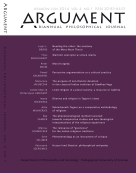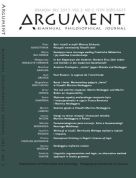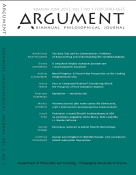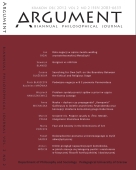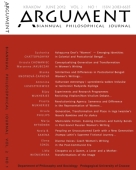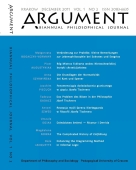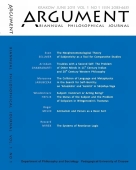e-ISSN 20841043
Kraków, June 2015, volume 5, number 1
SPIS TREŚCI

Temat wiodący numeru:
Psychofizyczna jedność ludzkiego Ja
Ujęcie porównawcze: filozofia, literatura i sztuka
redakcja Marzenna Jakubczak

Od redakcji
Introduction to the issue (Marzenna JAKUBCZAK) (5-8)
Artykuły i rozprawy
Maria VENIERI, Embodied mind and phenomenal consciousness (9-24)
Abstrakt
In recent years, a central debate in the philosophy of mind and cognitive science concerns the role of the body in perception and cognition. For many contemporary philosophers, not only cognition but also perception is connected mainly with the brain, where the processing of input from the senses takes place; whereas for the proponents of ‘embodied cognition’ other aspects of the body beyond the brain, including the environment, play a constitutive role in cognitive processes. In terms of perception, a new theory has emerged which stresses perception’s active character and claims that the embodied subject and the environment, with which it interacts, form a dynamic system. Supporters of ‘enactive perception’ such as Susan Hurley and Alva Noë maintain that the physical substrate or the supervenience basis of perceptual experience and phenomenal consciousness may include besides the brain and the nervous system other bodily and environmental features. Yet, it will be argued in this paper that the interaction between the subject and the environment forms a system of causal relations, so we can theoretically interfere in the causal chains and create hallucinations, which cannot be distinguished from veridical perception, or a virtual reality as in the film Matrix (1999). This kind of argument and its related thought experiments aim to stress the primacy of the brain in determining phenomenal states, and show that the body and certain interactions with the environment have a causal, but not a constitutive or essential role, in forming phenomenal consciousness.
Słowa kluczowe: philosophy of mind; cognitive process; embodied cognition; mind–body problem; Susan Hurley; Alva Noë; Evan Thompson
Marzenna JAKUBCZAK, The problem of psychophysical agency in the classical Sāṃkhya and Yoga perspective (25-34)
Abstrakt
TheThe paper discusses the issue of psychophysical agency in the context of Indian philosophy, focusing on the oldest preserved texts of the classical tradition of Sāṃkhya–Yoga. The author raises three major questions: What is action in terms of Sāṃkhyakārikā (ca. fifth century CE) and Yogasūtra (ca. third century CE)? Whose action is it, or what makes one an agent? What is a right and morally good action? The first part of the paper reconsiders a general idea of action – including actions that are deliberately done and those that ‘merely’ happen – identified by Patañjali and Ῑśvarakṛṣṇa as a permanent change or transformation (pariṇāma) determined by the universal principle of causation (satkārya). Then, a threefold categorization of actions according to their causes is presented, i.e. internal agency (ādhyātmika), external agency (ādhibhautika) and ‘divine’ agency (ādhidaivika). The second part of the paper undertakes the problem of the agent’s autonomy and the doer’s psychophysical integrity. The main issues that are exposed in this context include the relationship between an agent and the agent’s capacity for perception and cognition, as well as the crucial Sāṃkhya–Yoga distinction between ‘a doer’ and ‘the self’. The agent’s self-awareness and his or her moral self-esteem are also briefly examined. Moreover, the efficiency of action in present and future is discussed (i.e. karman, karmāśaya, saṃskāra, vāsanā), along with the criteria of a right act accomplished through meditative insight (samādhi) and moral discipline (yama). (yama).
Słowa kluczowe: action; agency; Indian philosophy; psychophysical integrity; mental causation; karman
Sonia KAMIŃSKA, Franz Kafka’s story The metamorphosis in the light of the theory of intentional object in Franz Brentano and Anton Marty (35-50)
Abstrakt
How does it feel to be a worm? No doubt, it feels Kafkaesque. The metamorphosis (1915) is a story of an ordinary man, Gregor Samsa, who wakes up one morning as an ungeheures Ungeziefer or ‘giant vermin’. Is this only a bodily change, or has his mind been transformed as well? And how do the people around him cope with this transformation? In this paper, I am going to examine these issues by using tools from Franz Brentano’s (1838–1917) and Anton Marty’s (1847–1914) philosophy of mind and language. Rumour has it that Kafka’s stories were not only products of his own troubled soul, but were also profoundly influenced by the work of these two philosophers. In my paper, I will cover the following issues: the influence of Franz Brentano on Anton Marty and a fortiori on Franz Kafka (1883–1924), who was Marty’s student in Prague (and in this way, saying something about the School of Brentano); Brentano’s and Marty’s theory of correct and incorrect emotions, and its traces in Kafka’s The metamorphosis; Marty’s philosophy of language and communication as reflected in Kafka’s writings; and Brentano’s reism in comparison to Kafka’s nominalism, on the basis of Roberto Calasso’s interpretation of Kafka.
Słowa kluczowe: intentionality; theory of emotion; correct emotion; philosophy of mind; philosophy of language; school of Brentano; intersection between literature and philosophy; body; soul
Elżbieta KOŁDRZAK, Plaisir and jouissance. The case of potential and textual reading of Barthes’ theory (51-58)
Abstrakt
The article is an attempt of the analysis and the interpretation of the categories ‘pleasure’ (Fr. plaisir) and ‘delight’ (Fr. jouissance), in the context of philosophically oriented theoretical‑literary considerations of Roland Barthes, sacrificed to the mystery of experiencing of the love. The part first, referring mainly to Barthes’ works, recognises the range of the semantic field plaisir and jouissance, as categories basic for the textual language of the outstanding theoretician. The second part introduces three examples of western cultural practices which illustrate the manner of use plaisir and jouissance as the factors of textual structures.
Słowa kluczowe: Roland Barthes; interpretation; theory of text; logo‑technique; thinking with body; theory of cultural practices
Ian W. KING, ‘What to wear?’: Clothing as an example of expression and intentionality (59-78)
Abstrakt
I will argue here that for many of us the act of dressing our bodies is evidence of intentional expression before different audiences. It is important to appreciate that intentionality enables us to understand how and why we act the way we do. The novel (and potentially significant) contribution this paper makes to this examination is employing clothing as a means of revealing the characteristics of intentionality. In that, it is rare to identify one exemplar that successfully captures the relationships between the cognitive and physical characteristics of its application. Nevertheless, this paper will not attempt to fully encompass the traditional approaches associated with this concept but instead employ both the early and later writings of French phenomenologist Maurice Merleau‑Ponty and his claim that our lived bodies are an expressive space from which we act intentionally. In other words (and this is critical for the approach of this paper), that the manner by which we dress our bodies is likely to offer a significant means of revealing the character of intentionality in everyday life and by this, claim that clothing can communicate. Accordingly, this first‑person account closely examines both the cognitive and physical experience of a simple clothing example: ‘what to wear?’ and the experience of an everyday clothing purchase in a store and its subsequent impact when the item of clothing is worn for different audiences. The ensuing discussion systematically examines the significance of marrying Merleau‑Ponty’s writings with this everyday example through private and public audiences and in abstract and public spaces.
Słowa kluczowe: Maurice Merleau‑Ponty; reversibility; dress; expression; intentionality; bodily communication; public audience
Elżbieta STANISZEWSKA, The human body: From its instrumentality to its axiological precedence in the contemporary art of design (79-86)
Abstrakt
Heidegger’s notion of ‘handiness’ combines two meanings, which in my view should be separated. They both refer to ways of characterizing tools in a given culture. Every culture uses tools, and they are all used so they are ‘handy’. The question is: Handy with regard to what? Two answers come to mind. The first one suggests that handiness is typical of the aims achieved in a given culture, which are linked with that culture’s system of values. Having been fulfilled, the aims seem to disappear, but new ones emerge and the cultural values are all the time appreciated. The aims and values constitute a part of the vision of the world accepted by the members of a given cultural community. In such a context, we can understand the handiness of tools as their optimum quality in facilitating the achievement of the aims which maintain the current cultural values, and so the existence of a given culture. The second answer links handiness with fulfilling the requirements of the human body. When considering the body in terms of its biological categories (as an organism) we can bear in mind its universal characteristics such as limbs, height, differences in body measurements, etc. In such a context, Martin Heidegger’s handiness can be understood pragmatically, as the features of a tool when adjusting it to the human body. In this paper, I propose a thesis that contemporary design loses handiness of the first type, while concentrating on making tools more and more comfortable for the human body. The cultural aims and values traditionally recognized in a given culture lose their priority, or seem to be ignored. At the same time, every tool user is given a chance to develop handiness of the first type. Whether we use this opportunity or not is another problem.
Słowa kluczowe: tool; the handiness of tools; Martin Heidegger; design; beyond practical values; bodily comfort; everyday aesthetics
Janusz WAŁEK, Between the ideal and the reality: The human body through the eyes of European artists (87-98)
Abstrakt
The human body has always been one of the most important subjects for European artists. But the way it is displayed in art has varied in different epochs. In ancient Greece, a canon was constituted that proclaimed an ideal vision of the body, derived from the rules governing the universe. This idealization of the human body, neglected in the Middle Ages, was re‑established in Renaissance and Classicist art. However, Renaissance artists also created another image of the human body by borrowing from patterns mainly found in nature, and started to depict their models not in an ideal but rather in a more natural shape. The new non‑ideal forms of art that appeared in Mannerist art made the artists develop a much wider artistic language, which brought into being a variety of individually interpreted artistic representations of the human body. It preceded similar phenomena which became widespread in the twentieth century. Thus, the human body was not always displayed in art as strong, healthy and beautiful. On the contrary, the martyred bodies of Christ and the saints, as well as the depictions of aged, tired or ill people, also carried enormous artistic expression. A distinct problem has occurred with the ways in which corpses have been presented in art. The review concludes with a reference to the contemporary trend called Body‑Art that involves various artistic activities, such as happenings and performances, where the human body is itself used as a significant work of art.
Słowa kluczowe: European painting; image of human body; body in art; idealization of human body
Maria POPCZYK, The image of the body-face: The case of Franz X. Messerschmidt and Bill Viola (99-110)
Abstrakt
In this paper, I am predominantly interested in interpretations of emotional states portrayed in images of the face. In particular, the interpretations which have grown around the series of busts by Franz Xaver Messerschmidt, as well as those which attempt to expound Bill Viola’s video works. I will refer to aspects of physiognomy, artistic practices and aesthetics, in order to show what each of these tells us about our attitude to the body and emotions and what happens to the body while a person is experiencing an emotion. My aim is to demonstrate how the act of depicting the body, regarded as a cognitive process in an artistic medium accompanied by a special kind of aesthetic experience, becomes a means of communication which is capable of conveying a universal message and of allowing us to define our attitude to the body.
Słowa kluczowe: body; physionomy; aesthetics; art; emotion; Franz Xaver Messerschmidt; Bill Viola; contemporary art; bodily expression
Iwona MILEWSKA, Female and male attractiveness as depicted in the Vanaparvan of the Mahābhārata (111-126)
Abstrakt
This paper deals with the bodily attractiveness of heroines and heroes, as described in one of the two most important epics of India. The basis for this analysis is the love stories and episodes included in the main plot of the Vanaparvan, the third book of the Mahābhārata. The stories from this book have been taken into consideration due to their numerous occurrences, which are a sufficient ground for generalizations. Many characteristic features of their protagonists are repeated in different sub‑stories. Also, the images of female and male characters, princesses, queens and kings are presented and discussed in detail. The external beauty of such female heroines as Damayantī, Sāvitrī, Sukanyā, Suśobhanā and Sitā; as well as the attractiveness of two semi‑goddesses, called Apsarases, are described and analysed. The names of the Apsarases discussed in the context of female beauty are Urvaśī and Menakā. Besides this, the image of an unnamed courtesan is discussed, as it is the most detailed description of a female character and probably follows the ideal of female beauty as shown in the Mahābhārata. As far as the male protagonists are concerned, the images of heroes such as Nala, Bhīma, Aśvapati, Rāma and Daśaratha are taken into consideration. The examples of male attractiveness also include features of the five main heroes of the Mahābhārata: the Paṇḍava brothers.
Słowa kluczowe: Sanskrit literature; Indian epics; Mahābhārata; beauty; female and male attractiveness
Beata ROMANOWICZ, Manifestation of the Kabuki actors’ gender in woodblock prints of the Edo Period (127-134)
Abstrakt
The connection between Kabuki theatre and Japanese woodblock prints of the Edo period (1603–1868), especially in their portraits of actors called yakusha‑e, offers an exceptional opportunity to analyse perceptions of the sex of the actor: as the hero of the drama, as well as the character performed on the stage. Both phenomena flourished in the Edo period and had a crucial impact on the visual art of the time, inspiring pictures of the Floating World (Jap. Ukiyo‑e). The images on Ukiyo‑e woodblock prints serve as a pretext for approaching the matter of whether to portray an actor as a performer (a man) or as the character performed by him (which could also be a woman, as in the case of the onnagata actor). The author focuses on the actors’ identification with their own sex (only men appeared on the Kabuki stage) and on cases of breaking the convention between the real actor and his stage emploi. In the first part, the paper discusses the historical background of Kabuki theatre, which was invented by a woman (Izumo‑no Okuni) and then after a few government edicts, was allowed to be performed on the stage only by adult men. Since the Kabuki tradition has successfully continued until today, apart from surveys of theatrical archives, the author supports her arguments by also referring to contemporary phenomena, especially the Kabuki performances she has watched in Japan (in such theatres as: Kabuki‑za, Minami‑za, the National Theatre in Tokyo, and Zenshin‑za), and through interviews with actors and people of the theatre. In parallel, Ukiyo‑e images of the Edo period are studied, with core research from the National Museum in Kraków, Poland, and its collection of Japanese woodblock prints (including over 4600 original works from the Edo Period), and with special attention paid to the yakusha‑e portrait by Utagawa Kuniyoshi.
Słowa kluczowe: Japanese art; Japanese aesthetics; Kabuki theatre; gender; the Edo period
Witold WACHOWSKI, Płeć kulturowa w rozproszonych systemach poznawczych – możliwości konceptualizacji (135-150)
Abstrakt
Gender in distributed cognitive systems: Possible conceptualizations
There is a mismatch between social and biological approaches in the studies on sex and gender. Neurofeminist researchers critically examine gendered impacts of research in neuroscience and cognitive science, as well as develop more adequate and gender‑appropriate
neuroscientific studies. However, they still seem to be focused on the brain and its relationship with the environment. Moreover, there are a little ‘science‑phobic’ feminist approaches based on actor‑network theory, and social science and technology studies. In this context, I would like to suggest another account of gender. My account is not centered on individual selves, minds or brains, but it is based on concept of distributed cognitive system and cultural ecosystem developed in the cognitive science. The potential integrational role of the approach seems worthy of attention. On the one hand, there are no contradictions between more important assumptions of distributed cognition theory and social studies. On the other hand, it is not necessarily limited to human beings and their minds. I pay particular attention to distinction between the distributed cognition theory and the extended mind theory. Ones of the most important elements of the ‘gender‑sensitive’ distributed system are artifacts and their affordances, most of all — cultural and canonical ones. In this light, the gender relations seem not only distributed, but also able to be designed.
Słowa kluczowe: actor‑network theory; affordance; cognition; cognitive science; feminism; science and technology studies
Markus LIPOWICZ, (Nie)święte ciało – socjologiczny i filozoficzny wymiar okrucieństwa we współczesnym filmie (151-170)
Abstrakt
(Un)holy body: The sociological and philosophical dimensions of cruelty in contemporary film
The aim of the present article is an attempt to analyse and interpret cinematic cruelty from a sociological and philosophical perspective. Contrary to the received wisdom, where film violence results on the viewers’ side from the destructive aspects of human nature and on the producers’ side from the desire for material profit, the author presents an alternative approach to this social phenomenon. The main thesis is that gore in movies poses a more or less fulfilling artistic commentary on actual social relationships and contemporary cultural conditions. The line of the argument is divided into three parts: in the first part, the author describes the modern transition from a transcendental to a transgressive understanding of the body and of corporeality; in the second part, the author presents the issue of cultural fascination with cruelty, from a sociological and also from a historical perspective; in the third and last part, the author analyses and interprets the respective aspects of three selected violent movies, pointing out their sociological and philosophical implications. The main methodological premise is posed by the concept of the ‘productive viewer’ from Rainer Winter, according to which the viewer is not a passive perceiver of art, but is an active and interpretive subject of the pictures on the basis of their contemporary cultural meanings and content.
Słowa kluczowe: cruelty; violence; body; objectification; society; cinema; media
* * *
Krzysztof JAKUBCZAK, Zagadnienie tożsamości bytu w filozofii buddyjskiej (171-178)
Abstrakt
The problem of identity of being in Buddhist philosophy
The Buddhist philosophical school of Madhyamaka is famous for its statement that things do not have their own inherent nature, essence or self‑nature (svabhāva). As a result, it is said that there is no objective foundation of the identity of things. Thus, the identity of things is not grounded in things themselves but is solely imputed and externally imposed on them. Things are what they are only for us, whereas for themselves, or from their ‘own side’ they are empty (śūnya). That is why Madhyamaka philosophy is often compared to the philosophical conceptions inspired by a linguistic reflection (from Ludwig Wittgenstein to Jacques Derrida) which defines the problem of identity in terms of cognitive subjectivism and constructivism. Starting the analysis from the Abhidharma Buddhist tradition I will show that this reading of Madhyamaka view is too narrow. I will demonstrate that it is a result of an assumption, shared by Parmenides and Plato and wrongly ascribed to this Buddhist school, that the identity of being must be grounded in the self‑existing, self‑defined and (relatively) permanent ontological foundation. This tacit assumption, if rejected, makes any identity a completely subjective and relative construct. The point I am going to argue for, however, is that the Madhyamaka school sticks to an alternative understanding of objectivity; the foundation of all things is nothing but pure relation that precedes, in the ontological sense, all co‑related elements (i.e. things). Therefore, the question comes up: how being‑in‑relationship or ‘relationality’ may be the foundation of identity and what kind of identity it endows. I will try to answer these questions.
Słowa kluczowe: Buddhist philosophy; Madhyamaka; Nāgārjuna; selflessness; identity; dependent origination; ontological foundation; ontological reductionism; relation
Jan WAWRZYNIAK, Miejsce i rola kryteriów w filozofii Wittgensteina (179-190)
Abstrakt
The role of criteria in Wittgenstein’s philosophy
The main objective of this article is to explain the role of the concept of a ‘criterion’ in Ludwig Wittgenstein’s philosophy. To do so, the author juxtaposes a few well‑known interpretations of this issue, and compares the notion of a criterion with the notion of a rule. Contrary to Peter M.S. Hacker’s reading, he points out that according to Wittgenstein, to give the ‘criteria of use’ of an expression is to determine its ‘grammar’. To meet the criteria does not merely mean justifying the fact that a given thing occurs, but means that a given expression has an application under the particular conditions. Thus, there is no difference between the determination of the criteria of an expression’s use and the explication of its meaning. It should be noted that the fact that the expression ‘x’ has an application in a given situation does not always imply that the sentence ‘this is x’ is also true in this situation. The Wittgensteinian notion of a criterion is a semantical rather than an epistemological concept. Therefore, the conceived criteria cannot be used to reject scepticism, if by rejecting it we mean demonstrating its falsity. According to Wittgenstein, we can show at most that a sceptic, who rejects all criteria of use of words, cannot frame any doubts.
Słowa kluczowe: Ludwig Wittgenstein; criterion; rule; meaning; grammar; theory of knowledge
Janusz A. MAJCHEREK, Dylematy i paradoksy etycznego ekstensjonalizmu (191-210)
Abstrakt
Dilemmas and paradoxes in ethical extensionalism
The principal postulate of environmental ethics is to include animals, or even all living entities, in the moral universe. However, questions include: Does this equally concern rats, mice, mosquitoes, bugs, parasites and other creatures which are dangerous for people’s health and life? If not, what are the criteria for selecting protected living beings and unprotected ones? Aren’t such criteria anthropocentric, and contrary to the biocentric assumptions of environmental ethics? Do the differences between the assumptions of environmental ethics and human ethics affect the particular rules of these two kinds of ethics, demanding different kinds of behaviour (towards human and towards nonhuman beings)? How should we appraise people who respect one kind of ethics, but break the other? Could we recognize those who live and act accordingly to the ethics of respect for nature, but don’t respect human rights, as ethically good? And do animals have rights in the same way as human beings? Are they the same rights, or different rights? And if they are different, should they nonetheless have ethical sources and foundations? These are some of the main dilemmas of environmental ethics which are considered in this article.
Słowa kluczowe: speciesism; moral universe; animal rights; environmental ethics; biocentric perspective
Tomasz BORYCKI, Spór o korzenie nazizmu. Hannah Arendt i Erica Voegelina koncepcje źródeł zjawiska (211-228)
Abstrakt
The dispute over the origins of Nazism: Hannah Arendt’s and Eric Vogelin’s views on the
sources of the phenomenon of Nazism.
Published in 1951, The origins of totalitarianism was a quantum leap in Hannah Arendt’s academic career. The book made her one of the most important scholars of Nazi ideology. Arendt’s work also won wide acclaim, partly due to a critical review by Eric Voegelin, which did not remain without responses from the author (both in public and in private correspondence). This paper tries to reconstruct the debates of Hannah Arendt and Eric Voegelin (including in the articles New science of politics and Some problems of German hegemony) on the origins of Nazism.
Słowa kluczowe: Hannah Arendt; Eric Voegelin; totalitarianism; political philosophy in the twentieth century
Paulina SURY, Sztuka i przestrzeń. Pawła Florenskiego interpretacja kategorii przestrzenności (229-242)
Abstrakt
Art and space: Pavel Florensky’s interpretation of the category of spatiality.
This paper attempts to acquaint Polish readers with the Russian Orthodox philosopher Pavel Florensky’s (1882–1937) thinking on the category of space‑ness, which together with the categories of symbolism and light is one of the key‑words in his theory of aesthetics. The concept of space is, according to Florensky, a criterion for distinguishing art types, although for him it is only a model, which can be used to help form judgments about the world. It is also the basis of being for the artwork itself. Painting and printmaking, among other arts types mentioned by Florensky (poetry, music, theatre, and architecture), have their own particularities in their organization of space. Painting and printmaking are, for Florensky, the truest art forms — art par excellence. The presentation of a threefold interpretation of the category of space‑ness, together with the description and justification of the divisions which are made in art based on these spatial categories by the philosopher is the leitmotiv of this paper. The aim of the paper is to present and discuss the opinions and arguments of the Orthodox thinker from his work Анализ пространственности (и времени) в художественно‑изобразительных произведениях, which has not yet been translated into Polish or English.
Słowa kluczowe: image of reality; mind projects; space‑system/space‑structure; painting and printmaking; theatre; poetry
Filozofia nauczania
Wendy LEE GROSSKOPF, When win-argument pedagogy is a loss for the composition classroom (243-266)
Abstrakt
Despite the effort educators put into developing in students the critical writing and thinking skills needed to compose effective arguments, undergraduate college students are often accused of churning out essays lacking in creative and critical thought, arguments too obviously formulated and with sides too sharply drawn. Theories abound as to why these deficiencies are rampant. Some blame students’ immature cognitive and emotional development for these lacks. Others put the blame of lackadaisical output on the assigning of shopworn writing subjects, assigned topics such as on American laws and attitudes about capital punishment and abortion. Although these factors might contribute to faulty written output in some cases, the prevailing hindrance is our very pedagogy, a system in which students are rewarded for composing the very type of argument we wish to avoid — the eristic, in which the goal is not truth seeking, but successfully disputing another’s argument. Certainly the eristic argument is the intended solution in cases when a clear‑cut outcome is needed, such as in legal battles and political campaigns when there can only be one winner. However, teaching mainly or exclusively the eristic, as is done in most composition classrooms today, halts the advancement of these higher‑order inquiry skills we try developing in our students.
Słowa kluczowe: tagmemics; composition; win‑rhetoric; dissoi logoi; pedagogy; argumentation
Artykuły przeglądowe
Akiko KASUYA, Art and the body: The Tatsuno Art Project (267-274)
Abstrakt
The author discusses the relationship between art and the body, as exemplified by the similarities and differences in the works of: two Japanese artists, Matsui Chie (b. 1960) and Higashikage Tomohiro (b. 1978); and the Polish artist, Mirosław Bałka (b. 1958). These examples are referred to in the context of a unique project recently conducted in Japan — the Tatsuno Art Project 2013. Held with the support of the Agency for Cultural Affairs of Japan, the project aims to present contemporary art to people from across Japan and around the globe, and to capitalize on the region’s unique cultural heritage, creating opportunities for people to communicate with local residents and making Tatsuno a more dynamic and popular place to visit. This paper considers various connections between art and the body by focusing on a selection of works included in the Tatsuno Art Project 2013: Arts and Memories. Known in past centuries as the ‘little Kyoto’ of Harima Province, Tatsuno is an atmospheric old castle town. It is mild and relatively warm all year round, with the climate of the nearby Seto Inland Sea region, said to be similar to that of the Mediterranean. Thanks to the support of numerous people, the organizers were able to hold the 2013 event which represented the culmination of their efforts over the past few years, being the largest ever in terms of scale with nine invited artists, eleven other participating artists, and one contemporary musician, for a total of 21 creators contributing works. With new spaces added to create a total of 16 venues, the community‑wide project truly achieved its goal of presenting the ‘historic castle town as a museum’. The project curators were also able to strengthen Tatsuno’s international ties by inviting artists from France and Poland to take part, as well as Japanese artists residing in the UK and Spain.
Słowa kluczowe: body in art; Japanese art and culture; transcultural aesthetics; contemporary art; town as a museum; community based art project
Okiem filozOFFa
Piotr BARTULA, Dwa raporty (275-284)
Recenzje książek i noty
Seweryn Blandzi, Między aletejologią Parmenidesa a ontoteologią Filona. Rekonstrukcyjne studia historyczno-genetyczne. Rec. Jan BIGAJ (285-290)
Słowa kluczowe
filozofia starożytna, filozofia grecka, prawda, aleteja, Parenides, Filon
Roman Darowski SJ, Philosophical anthropology. Outline of fundamental problems. Rec. Rafał KUPCZAK (291-293)
Słowa kluczowe
filozofia człowieka, antropologia filozoficzna, filozofia współczesna, historia filozofii
Bartosz Brożek i Mateusz Hohol, Umysł matematyczny. Rec. Hubert BOŻEK (295-303)
Słowa kluczowe
filozofia umysłu, filozofia matematyki, filozofia a nauka
Bernard-Henry Lévy, De la guerre en philosophie. Rec. Witold WIETESKA (305-311)
Słowa kluczowe
metafizyka, nihilizm, filozofia francuska
Albert Piette, Existence in the details: Theory and methodology in existential anthropology. Rec. Katarzyna GURCZYŃSKA-SADY (313-314)
Słowa kluczowe
antropolofia egzystencjalna, filozofia egzystencji, metodologia filozofii
Sprawozdania z konferencji
X Polski Zjazd Filozoficzny w Poznaniu – Włodzimierz HEFLIK & Maciej URBANEK (315-317)
Autorzy tomu
Pełny tekst (319-321)


